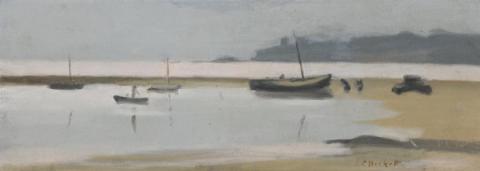MISTY DAY, TOWARDS BLACK ROCK
Clarice Beckett
oil on board
23.5 x 60.5 cm
signed lower right: C Beckett
Private collection, Melbourne
Deutscher~Menzies, Melbourne, 24 November 1999, lot 11
Private collection, Melbourne
Towards Black Rock, illustrated in Hollinrake, R., Clarice Beckett: The Artist and Her Circle, Macmillan, Melbourne, 1979, p. 44
The art of Clarice Beckett aspires towards the moods music, nuanced by the poetic. 'My pictures like music', she said, 'should speak for themselves.'1 Her imagery may be of flowers, bathing boxes, the beaches of Beaumaris, bridges across the Yarra River, and motor lights; but her subjects dwell in a different sphere - of beauty, peace, light and colour. They are touched with dreams of the ineffable, of transient dawn and twilight brushed with mystery, and foggy nights. They are likewise about recollection, of sparkling sunlight on bayside sands, reflections on the mirrored surfaces of water, the warmth of a summer's day, and the majesty of stormy seas. Combined with their considerable aesthetic appeal, such reflections are readily shared, giving these works their irresistible attraction. As Wordsworth said of poetry, her art 'takes its origin from emotion recollected in tranquillity.'2
Misty Day, Towards Black Rock is one such delightfully characteristic work in which the affinities with music are readily apparent. Colours and forms combine in horizons of harmony, of pictorial recession and restatement flowing across the picture plane. Other words - rhythm and tone - also common to music and painting, extend the association and please the sensibilities. The elegantly extended format of the painting and its gentle tonal responses evoke in the mind further analogies to music, the romance of a nocturne, an Etude, the sonata transformed into the sonnet. This and other paintings by Beckett encompass the sounds and feelings of words, Keats's 'season of mists' is not out of place here, even if his 'mellow fruitfulness' may be.3 Living at Beaumaris on Port Phillip Bay, Beckett often painted the beach and sea in its various moods and seasons, and of Black Rock nearby. The subject of boats beached or their reflections in morning and evening calm caught her attention. Such paintings as Misty Evening, Beaumaris 1930 and Silver Morning (Near Beaumaris) c.1931 eventually found their way into the notable collections of the Art Gallery of Ballarat and the Castlemaine Art Gallery and Historical Museum. Her poetic mastery was such that even the most prosaic bathing boxes were transformed, no better seen than in Sandringham Beach c1933 in the National Gallery of Australia, Canberra.
1. Quoted in Hollinrake, R., Clarice Beckett: Politically Incorrect, The Ian Potter Museum, University of Melbourne, 1999, p. 19
2. Wordsworth, W., Lyrical Ballads, 1802
3. Keats, J., To Autumn, 1820
DAVID THOMAS
